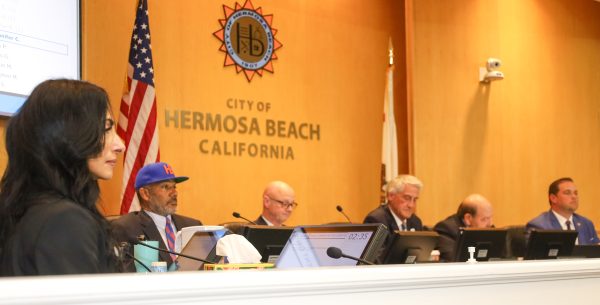
For the second time in less than a week, a potential Redondo Beach mixed-use development is on the road toward being denied by city decision-makers.
At Tuesday’s Redondo Beach City Council meeting, a public hearing regarding the Cape Point project at 1914-1926 Pacific Coast Highway was continued by the council until next month, intended to give staff time to draft a denial.
The hearing was raised due to an appeal put forth by District 2 councilman Bill Brand, who did so on behalf of the public, with an emphasis on the Conditional Use Permit issued by the city’s planning commission on May 21.
Public concerns centered on traffic impacts, particularly a fear that the development would jam the nearby intersection of Pacific Coast Highway and Prospect Avenue and increase traffic throughout the surrounding neighborhood. There were also concerns regarding the use of the project’s alleyway, shared with St. Lawrence Martyr Catholic Church, as an entrance for the project’s resident parking area.
The plan for the development, as described by Cape Point Development’s Nick Buchanan, calls for the demolition and replacement of the current structure, Sea Breeze Plaza. The new project would be a three-story structure featuring a subterranean parking level, 10,552 square feet of commercial space, 52 condominium units and 180 parking spaces over the 1.49 acre site.
Buchanan says that his company’s goal is to provide “quality housing in vibrant communities,” constructing projects that encourage walkability and making use of areas that are underutilized. “People want to be close to where the action is. It’s important to them,” Buchanan said.
The vision, he told the council, is to fill the project with young professionals, young families, empty-nesters and first-time homeowners.
Learning from challenges faced by Legado, Buchanan reached out to locals, earning praise from resident Rhonda Cress, who said that Buchanan “did everything to the best of his ability to get the public involved in what he wanted to do.”
Few other residents shared her excitement.
Amy Josefek, who helped organize opposition to Legado on July 16, returned to offer similar sentiments.
“This development has found a way to cram 52 condos on to too small a parcel,” she said. “Plus, an alley designed as entry and exit with maybe a 100-plus [resident] cars? That alley is barely wide enough for two-way traffic. It’s sheer lunacy.”
Her argument struck a chord with council, including Mayor Steve Aspel, who is a parishioner at St. Lawrence Martyr. Aspel recognized that parents often use the 20-foot-wide alley behind the church as a drop-off for their kids.
“I don’t see two cars getting out east and west of that thing,” Aspel said. “It may fit, but after years of driving down that myself, there’s going to be an issue with that alley.”
A major sticking point came from the submission of a letter from Caltrans, which called into question the traffic research data for the project. The letter, received by staff on July 14, requested a report studying traffic impact at four intersections meeting Pacific Coast Highway from Calle Mayor to Palos Verdes Boulevard.
The problem, according to Aspel, is that council didn’t get the letter until immediately before the meeting. He said to staff that “there’s no distrust, but when we get something the day of the meeting, this doesn’t look right.”
On advice from staff, Brand motioned to continue the appeal hearing to a later meeting, so staff would have the opportunity to draft a study of denial. The motion passed, 3-2, with dissent coming from District 1 councilman Jeff Ginsburg and District 5 councilwoman Laura Emdee.











